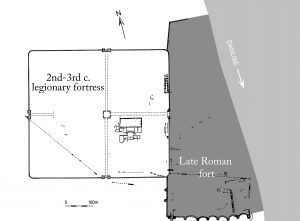Late Roman fortress
In Óbuda we can come across Roman remains or modern structures hiding them if we take a quick look every now and again to the right or the left. Last time, we presented the remains of the cella trichora, Early Christian funerary chapel. By the time the chapel was built in the mid-4th century, the inhabited areas of the Military Town had shrunk significantly and shifted to the vicinity of the Late Roman fortress. It is at this military installation that we continue the Aquincum traffic jam blog.
So where are we now?
We’re on Serfőző Street, turning right onto Árpád Fejedelem Road, where we pass a small park. Between the park and the Aquincum Hotel Budapest’s car park, a different pattern on the pavement draws our attention to the traces of the Late Roman town’s most significant military structure.
But first the history!
The late-3rd and early-4th century brought conflict with the Quadi and Sarmatians and increased the need for defences. And so, in the Aquincum Military Town, under Constantine the Great in the 330s a new, improved and much more massive fortress (castrum) was attached to the eastern wall of the earlier legionary fortress, reaching the bank of the Danube.
While the walls of the legionary fortress (built in stone in the 2nd century around modern-day Flórián Square) were 1.4 metres thick, the new walls of the Late Roman fort were over 3 metres thick. What was also new about the castrum was that in its southern half, the western and southern walls were fortified with protruding, horseshoe-shaped towers, and that the line of the southern wall curved inside between the towers.
We primarily know the southern and western walls of the Late Roman fortress. There have only been limited excavations inside the 720 x 300 metre area within the castrum walls. These indicate that buildings inside no longer followed the strict system of the previous centuries. Structures of the Military Town that stood in this area, e.g. the building of the former port, were remodelled and used for new purposes following the construction of the fortress. The military forces occupied the southern half of the fort, while the more loosely built up northern part provided refuge for the civilian population.
During the last third of the 4th century, the size of the fortress was reduced in the north. The northern wall of the smaller fort (measuring roughly 300 x 300 metres) lay under modern-day Fő Square. The castrum continued to provide protection also after the end of Roman rule. Its walls were even used for new buildings in the Middle Ages.

What can we see today?
Unfortunately, not much can be seen of the Late Roman fortress. Its remaining stones were quarried in the modern period for lime-burning and constructions. However, walking in the park by Árpád Bridge, with the help of the pavement, we can explore the line of the southern wall’s curving sections and the ground plan of the attached towers.
Soon we’ll continue our search for Roman remains as there are still plenty of other hidden and conspicuous monuments to discover in Óbuda; but more on those later.
All in all, I encourage everyone to have a look at the park marking the site Late Roman fortress’s southern wall on foot, or from your car on a sunny spring morning – but only when the traffic isn’t moving!
Zoltán Quittner
Click here to read the previous entries of the Aquincum traffic jam blog!


